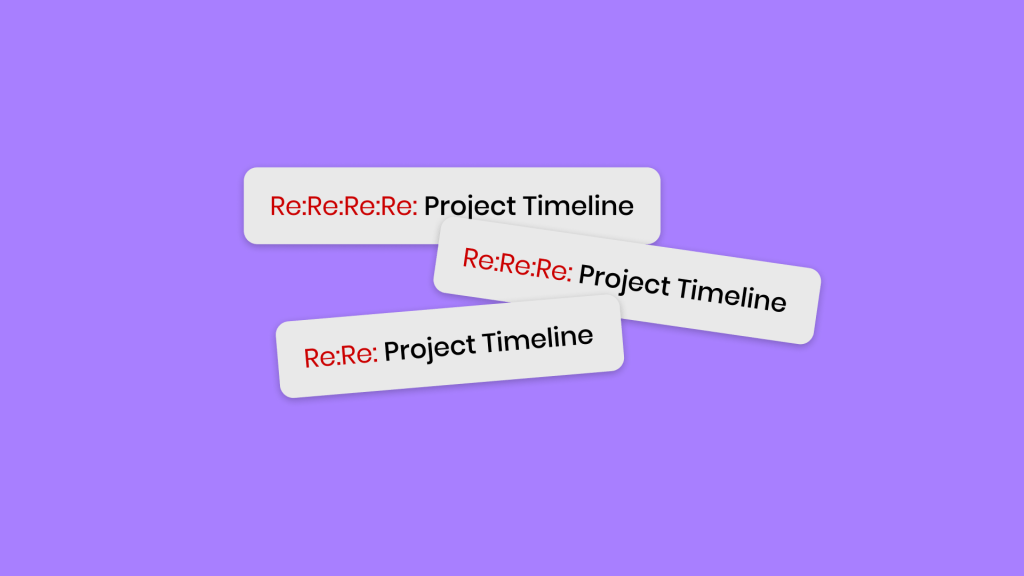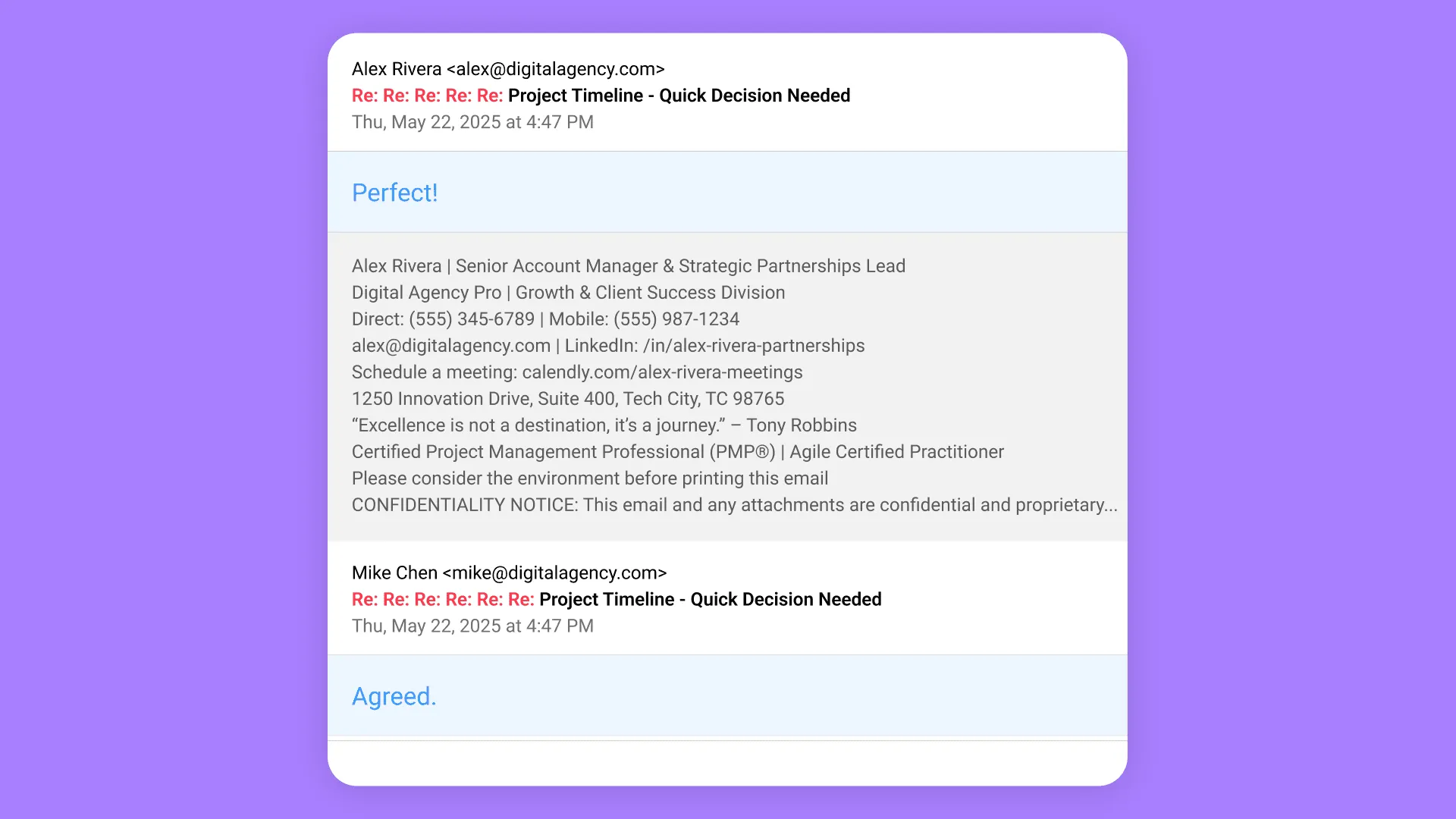Why your best ideas get lost between chat and email. The Messy Middle of modern collaboration

Your communication tools are killing your best work. A project starts with a breakthrough in a Zoom meeting, continues through email threads, fragments across Slack channels. After weeks of real progress, you pause and ask: where did all that thinking go?
One insight lies buried 100 messages deep in a Slack channel that has moved on to discussing lunch plans. Another lives in a Google Doc that someone created but forgot to share with anyone outside their immediate team. The most critical decision drowns in a serpentine email thread where half the stakeholders vanished after the fourth “Reply All.”
So we build protocols. This type of communication goes here, that goes there, everything else gets saved in the cloud. But real thinking is messy, fluid, informal. It defies neat categorization and rigid rules. You need a space to just think together, but it cannot be cut off from where the work actually lives.
The Messy Middle is where strategy happens, but current tools can’t capture. Too fluid for formal platforms, too complex for chat. Here, deep thought collides with iterative discussion. Innovation suffocates under communication friction. Your competitive advantage slowly dies.
What the Messy Middle actually looks like
Most people think the Messy Middle is just another collaboration problem. It’s not. It’s the specific space where work is too complex for quick chat but too iterative for formal email. This is where your business actually moves forward.
Think about what your team does every day:
Building a feature specification.
You need input from engineering, design, and marketing. Technical constraints have to balance against user needs and business goals. No quick Slack poll will solve this. You need a living document that grows with thoughtful input and real feedback.
Deciding on a strategic pivot.
You need to capture not just the decision, but why you made it. What alternatives did you consider? What risks did you weigh? Six months later, when someone questions the choice, that thinking becomes critical.
Giving creative feedback on a campaign.
You’re referencing specific elements, suggesting alternatives, building on others’ ideas. The conversation needs to flow naturally while keeping the visual context that sparked each comment.
This work is the core of what your organization does. Innovation happens here. Complex problems get solved here. Real alignment emerges here.
Your tools are systematically destroying it.

Chat is built for speed, not substance
Slack and Teams were built for one thing: what’s happening right now. Every design choice proves it: the real-time notifications, the scrolling interface, the pressure to respond quickly.
You’re trying to think through a complex strategy, but the medium demands you chop your thoughts into bite-sized pieces that can survive in a stream of consciousness.
Complex ideas don’t work that way. When you try to explain why your pricing model doesn’t match customer behavior, you post a series of messages that get interrupted by someone asking about the coffee machine. Context breaks apart. Threads die.
The platform has no memory. Try finding that brilliant insight from three weeks ago. The relentless forward momentum of the stream has consumed it completely.
Email is built for clarity, not collaboration
Email swings to the opposite extreme. It was designed as digital mail, discrete messages between individuals, built for formal, complete thoughts.
When you apply this to collaborative work, it creates its own problems. Every iteration spawns a new thread. Each person sees a different version of the conversation based on when they joined and which replies they got.
That “Reply All” chain that seemed manageable with four people? With eight, it becomes incomprehensible. Context splits across multiple inboxes. Version control becomes a nightmare.
Email treats collaboration like a series of individual letters instead of a shared conversation. You might as well brainstorm by passing notes.
Building tools for how thinking actually works
Understanding why current tools fail shows us what a real solution needs. Instead of making email faster or chat slower, we need to design around how the Messy Middle work actually happens.
A proper tool treats each topic as one coherent conversation space. All related discussion, files, decisions, and tasks live in the same thread.
But this goes deeper than threading messages. You need a persistent workspace where conversation, docs, and deliverables grow together. When someone mentions “the pricing concerns we discussed,” the system should preserve that exact context instead of making you hunt through scattered channels.
The conversation becomes a searchable record that captures both decisions and the thinking behind them. Six months from now, when your replacement needs to understand why you chose this architecture or rejected that approach, the reasoning should be preserved and easy to find.
This transforms communication from temporary coordination into lasting knowledge. Every important discussion becomes part of your organization’s intellectual capital instead of disappearing into the void.
Any tool must support what real collaboration looks like, fluid enough for natural back-and-forth, structured enough for thoughtful contribution. It should respect that complex thinking takes uninterrupted time while enabling the iterative exchange that sharpens ideas.
This means building interaction patterns that invite considered responses instead of demanding instant reactions. It means making it easy to pick up a conversation after two days and contribute meaningfully without reading dozens of messages.
Stop accepting broken tools
The chaos your team lives with isn’t inevitable. You’re trying to force high-value work into tools built for simple coordination and formal documentation.
Whatever tool you choose, your communication system must treat strategic discussion as real work, not digital garbage.
At Spike, we built communication around the Messy Middle from scratch. Our Conversational Email turns email threads into coherent conversation spaces where context builds instead of fragments.
Integrated Notes and Docs let deep thinking live alongside dynamic discussion, creating lasting knowledge that builds your team’s intellectual capital. The interface supports natural async work, thoughtful when needed, and responsive when appropriate.
Your communication chaos isn’t inevitable. The wrong tools are killing your best work.
You can’t build strategy in a chat box. You can’t iterate it over email. It’s time to build a space where real thinking lives.




